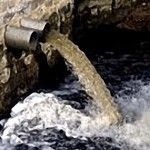 |
| © Unknown |
Over the past several decades, U.S. industries have injected more than 30 trillion gallons of toxic liquid deep into the earth, using broad expanses of the nation's geology as an invisible dumping ground.
No company would be allowed to pour such dangerous chemicals into the rivers or onto the soil. But until recently, scientists and environmental officials have assumed that deep layers of rock beneath the earth would safely entomb the waste for millennia.
There are growing signs they were mistaken.
Records from disparate corners of the United States show that wells drilled to bury this waste deep beneath the ground have repeatedly leaked, sending dangerous chemicals and waste gurgling to the surface or, on occasion, seeping into shallow aquifers that store a significant portion of the nation's drinking water.
In 2010, contaminants from such a well bubbled up in a west Los Angeles dog park. Within the past three years, similar fountains of oil and gas drilling waste have appeared in Oklahoma and Louisiana. In South Florida, 20 of the nation's most stringently regulated disposal wells failed in the early 1990s, releasing partly treated sewage into aquifers that may one day be needed to supply Miami's drinking water.
Federal officials and many geologists insist that the risks posed by all this dumping are minimal. Accidents are uncommon, they say, and groundwater reserves - from which most Americans get their drinking water - remain safe and far exceed any plausible threat posed by injecting toxic chemicals into the ground.
But in interviews, several key experts acknowledged that the idea that injection is safe rests on science that has not kept pace with reality, and on oversight that doesn't always work.
Some experts see the well failures and leaks discovered so far as signs of broader problems, raising concerns about how much pollution may be leaking out undetected. By the time the damage is discovered, they say, it could be irreversible.
"Are we heading down a path we might regret in the future?" said Anthony Ingraffea, a Cornell University engineering professor who has been an outspoken critic of claims that wells don't leak.
Highlights
"In 10 to 100 years we are going to find out that most of our groundwater is polluted," said Mario Salazar, an engineer who worked for 25 years as a technical expert with the EPA's underground injection program in Washington. "A lot of people are going to get sick, and a lot of people may die.
The U.S. Environmental Protection Agency, which has primary regulatory authority over the nation's injection wells, would not discuss specific well failures identified by ProPublica or make staffers available for interviews. The agency also declined to answer many questions in writing, though it sent responses to several.
According to risk analyses cited in EPA documents, a significant well leak that leads to water contamination is highly unlikely - on the order of one in a million. Once waste is underground, though, there are few ways to track how far it goes, how quickly or where it winds up. There is plenty of theory, but little data to prove the system works.

No comments:
Post a Comment